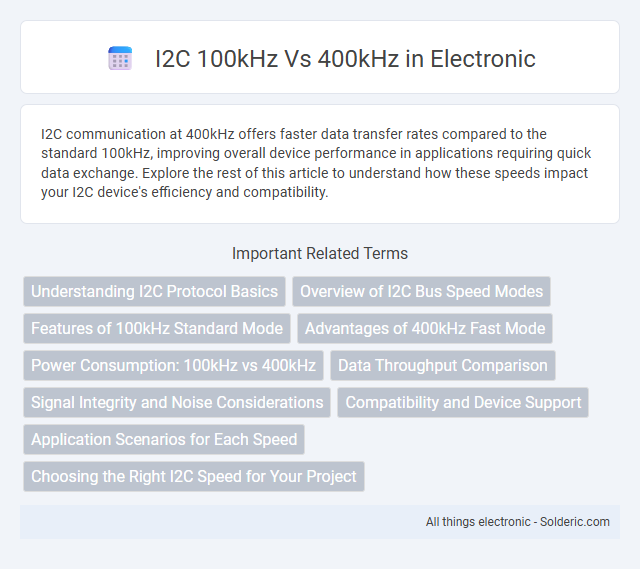I2C communication at 400kHz offers faster data transfer rates compared to the standard 100kHz, improving overall device performance in applications requiring quick data exchange. Explore the rest of this article to understand how these speeds impact your I2C device's efficiency and compatibility.
Comparison Table
| Feature | I2C 100kHz (Standard-mode) | I2C 400kHz (Fast-mode) |
|---|---|---|
| Data Transfer Rate | 100 kbps | 400 kbps |
| Maximum Bus Speed | 100 kHz clock frequency | 400 kHz clock frequency |
| Power Consumption | Lower, suitable for low-power applications | Higher due to increased switching frequency |
| Signal Integrity | Less susceptible to noise at lower speeds | More sensitive to noise and requires better PCB layout |
| Cable Length | Longer cable lengths supported (up to 1 meter typical) | Shorter cable lengths recommended due to higher speed |
| Compatibility | Works with all standard I2C devices | Works with devices supporting Fast-mode or higher |
| Use Case | Simple sensors, slow peripherals | High-speed peripherals, faster data communication |
Understanding I2C Protocol Basics
I2C protocol operates at standard mode with 100kHz and fast mode at 400kHz, defining data transfer speeds and timing requirements between devices. Understanding signal timing, clock stretching, and start/stop conditions is essential for optimizing your I2C communication at these speeds. Higher frequency like 400kHz offers faster data rates but requires better signal integrity and pull-up resistor considerations compared to 100kHz.
Overview of I2C Bus Speed Modes
I2C bus speed modes primarily include Standard Mode at 100kHz and Fast Mode at 400kHz, where the latter allows for quicker data transfer suitable for more demanding applications. Your choice between 100kHz and 400kHz depends on device compatibility, bus length, and noise environment because higher speeds may increase signal integrity challenges. Understanding these modes enables you to optimize communication speed and reliability in your embedded system projects.
Features of 100kHz Standard Mode
The 100kHz Standard Mode of I2C supports data transfer speeds up to 100 kilobits per second, providing reliable communication for most low-speed peripherals. It features a simpler timing specification, lower power consumption, and compatibility with a wide range of legacy devices. This mode ensures robust clock stretching, basic error detection, and standard addressing with 7-bit addressing format.
Advantages of 400kHz Fast Mode
400kHz Fast Mode I2C offers significantly faster data transfer rates compared to the standard 100kHz, enabling quicker communication between devices and reducing overall latency in embedded systems. This higher speed improves system responsiveness and efficiency, particularly in applications requiring rapid sensor data acquisition or high-speed peripheral control. Your designs benefit from enhanced throughput and the ability to support more complex or data-intensive operations without compromising stability.
Power Consumption: 100kHz vs 400kHz
I2C communication at 100kHz generally results in lower power consumption due to reduced switching frequency, which decreases dynamic power usage in both the master and slave devices. In contrast, 400kHz mode increases power consumption as devices toggle the data and clock lines more rapidly, leading to higher current draw during transitions. Designers must balance speed requirements with energy efficiency, especially in battery-powered applications where 100kHz operation extends battery life.
Data Throughput Comparison
I2C at 400kHz offers a data throughput approximately four times higher than the standard 100kHz mode, enabling faster communication between microcontrollers and peripherals. This increased speed significantly reduces latency in data transfers, which is critical for applications requiring timely sensor readings or rapid command execution. By utilizing 400kHz, Your system can achieve improved performance in data-intensive tasks without changing the bus hardware.
Signal Integrity and Noise Considerations
I2C communication at 100kHz generally offers better signal integrity with lower susceptibility to noise due to slower signal transitions and reduced electromagnetic interference, making it suitable for longer cable lengths or noisy environments. At 400kHz, faster data rates increase the risk of signal degradation and noise interference, requiring careful PCB layout, shorter trace lengths, and proper pull-up resistor selection to maintain reliable communication. Your choice between 100kHz and 400kHz should balance the need for speed with the robustness of signal integrity in your specific hardware setup.
Compatibility and Device Support
I2C devices operating at 100kHz are widely compatible with a vast range of legacy and modern components, ensuring broad device support across various platforms. In contrast, 400kHz mode requires peripherals explicitly rated for high-speed communication to avoid data corruption or communication failure. Your choice between 100kHz and 400kHz depends on the devices' datasheets and the need for faster data transfer balanced against guaranteed interoperability.
Application Scenarios for Each Speed
I2C at 100kHz is ideal for low-speed sensor communication and simple control devices in embedded systems, where power consumption and noise immunity are prioritized. The 400kHz fast-mode I2C suits applications requiring faster data transfer, such as display interfaces and EEPROM programming, where timely updates and higher throughput are crucial. Your device's performance demands and system complexity will determine the optimal I2C speed for reliable and efficient operation.
Choosing the Right I2C Speed for Your Project
Choosing the right I2C speed depends on your project's requirements for data transfer rate and reliability. I2C at 100kHz offers stable communication and lower power consumption, ideal for long cable runs or noisy environments, while 400kHz provides faster data rates suitable for high-speed sensors and real-time applications. Your selection should balance speed needs against signal integrity and power constraints to ensure optimal performance.
I2C 100kHz vs 400kHz Infographic

 solderic.com
solderic.com